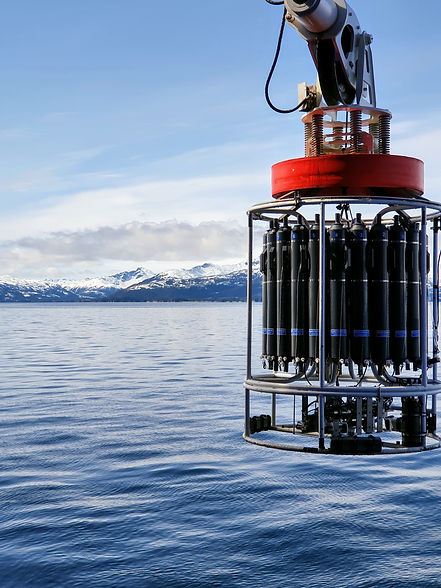

Benjamin Lowin
Welcome to Oceans of Light
This is my website, where I share the science on which I am working and connect with peers, collaborators, and anyone interested in this research.
Keywords: Bio-Optics, Remote Sensing, SeaHawk, Gliders, Primary Production, South Atlantic Bight
Current Research


Line Height Absorption (LHA):
Northern Gulf of Alaska case study
The LHA method, developed by Roesler and Barnard (2013), is used to estimate chlorophyll concentrations from absorption. Based on work I did in the Northern Gulf of Alaska, I show that there is a seasonality to the relationship between chlorophyll and absorption at 676 nm.

Validating SeaHawk Ocean Color:
A cube-sat mission
As part of the team working to validate the SeaHawk/Hawkeye cube-sat. I routinely do fieldwork in the region around Savannah to collect in situ validation data. I collect and process chlorophyll, total suspended sediments, and Colored Dissolved Organic Mater (CDOM) samples.

I was born in California and spent my childhood surfing in San Diego with my grandparents and going to the Monterey Bay Aquarium for school field trips. When I was 5 to 9 years old I swam competitively. When I was 10, my family moved to Switzerland. My parents, brother, sister, cat, and dog all flew over on November 11th, 2004.
In Switzerland, I learned just how bad I was at Skiing and French. I took to skiing as my major hobby in the winter, competing in races and being a bum in terrain parks. French left me tongue-tied and I still struggle with it. During this time I attended ISL and received an I.B. with higher-level courses in Biology, Art, and Economics.
I then chose where to do my undergraduate program based on being close to the mountains and the sea. I went to the University of British Columbia, in Vancouver. Here, I fell in love, played a lot of board games, ate great food, and learned what the word "oceanography" meant. I struggled to re-learn how to learn at a university level and took an extra year to graduate. Oh ya, and I spent every opportunity I got to go to Whistler/Blackcomb.
I then moved to Southampton, England, UK to study oceanography at a Master's level. The National Oceanographic Center there is a hotbed of research and intellectual conversation, though you will get lost and wonder why there is not a corridor where you expect it to be. England was more board games and I gained great apple cider. This was a one-year program, and it makes use of all 365 days.
At the end of this, I was briefly in Switzerland at the beginning of COVID. Then I found a position in Alaska working on a project to validate satellite imagery using bio-optics. This was a trial-by-fire experience and I grew and learned with every burnt finger and blistered hand. I spent nearly 70 days on the R/V Sikuliaq working on the inline system, submitted and revised my first grant, and learned that Alaska is cold and dark in the winter. The Northern lights are amazing but don't make up for the lack of sunlight. I ended my time here when my mentor deiced Alaska was not for him.
I now work at the Skidaway Institute of Oceanography. at the Bio-Optical and Satellite Oceanography Lab. I wear a few hats in the Lab; Ph.D. student, Lab Tech, independent researcher, and field scientist. This lets me enjoy all the aspects that brought me into this scientific field. I fell in love with the interdisciplinary nature of the research, going out on the ocean and helping the world.
About Me
Latest Publication
Design update to "The Pressure of In-situ Gases Instrument (PIGI) for autonomous ship-board measurement of dissolved O2 and N2 in surface ocean waters".
Abstract:
Measuring Net Community Production (NCP) is a challenging, but important, aspect of oceanography. Methods based on discrete sample collection often have low spatial and temporal resolution, while expensive instruments are required to obtain NCP measurements at high-resolution. To address these issues, Izett and Tortell (2020) created a novel, autonomous system called the Pressure of In-situ Gases Instrument (PIGI), and shared their design with the community. The system yields high-resolution surface water O2 and N2 measurements, which are used to estimate Net Community Production (NCP) along a ship transect or at a fixed field station. Here we provide a description of an updated PIGI instrument, which improves on some of the elements of the original design. We tested the updated design in November, 2022 in the coastal South Atlantic Bight; to our knowledge, these are the first continuous NCP estimates in the region. The data collected by the updated PIGI suggest that it performs equally well to the original, providing high resolution measurements and NCP estimates. The following documents the updates to the PIGI system, discusses the data collected and shares tips and tricks with the community. Updates to the system include a new water tight design and a software update. The estimated cost of the system has also been updated to $20,000 USD. We hope that this update will help support the community in using this system and lowering barriers to its further development.
Connect with me
Ben Lowin
Skidaway Institute of Oceanography & Univeristy of Georgia
PhD student and Research assistant
10 Ocean Science Ciricle, Savannah, Ga
Email: ben.lowin@uga.edu




